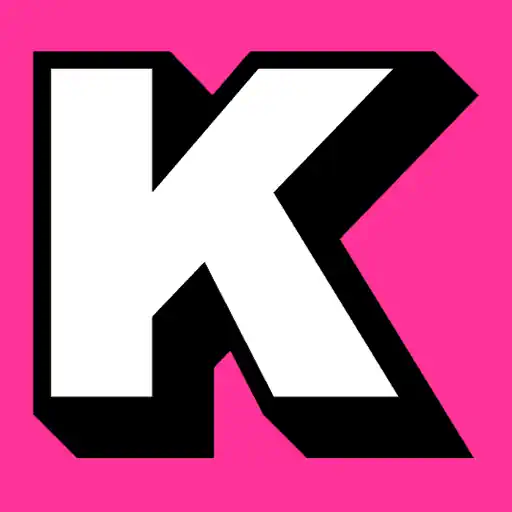Best Email Platform For Creators Looking To Start An Email List
| Feature | Kit (formerly ConvertKit) | Beehiiv | EmailOctopus |
| Best For | Serious Creators & Monetization | All-in-One Newsletter Publishing | Cost-Conscious Bloggers |
| Free Plan Allowance | 10,000 subscribers & Unlimited emails | 2,500 subscribers & Unlimited emails | 2,500 subscribers & 10,000 emails p/m |
| Key Standout Feature | Sell Digital Products & Subscriptions directly within the platform. | Website Builder & Custom Domain support for your newsletter archive. | Affiliate Marketing Friendly and very simple newsletter software. |
| Creator Tools Included | Landing Pages, Forms, Tagging, Segmentation | 3 Newsletters/Publications, Audience Growth Tools, Recommendation Network | Simple Newsletter Software |
| Major Free Plan Drawback | Limited to one visual automation and one email sequence; requires displaying the Creator Network. | No monetization tools (paid subscriptions) or email automations are accessible. | Limited range of features (no advanced automations); customer support only for the first 30 days. |
| Best For? | Best Overall, Editor’s Pick | Best For Newsletters | Best For Budget Conscious |
What We Recommend For Creators Right Now
For me, the best email marketing platform is the one that doesn’t nickel and dime you for everything.
That’s easy to use and can scale with you from zero to $100,000/mo without the need for additional staff and support.
And that comes with all the tools you need to grow and sell right out of the box.
Right now, Kit is the only one that ticks all these boxes for me which is why it is the only platform I use on all my main projects.
Creators Need Different Email Marketing Tools Than SAAS Companies & E-Commerce Brands

If you’re a creator, you need a platform built for content, not physical inventory or sprawling enterprise sales teams.
That means I won’t be covering platforms like MailChimp, MailModo, or Klaviyo in this guide.
I’ve used all of the platforms listed (above) and covered in more detail below on a range of projects and sites.
They all come with generous free tiers and most of the tools you’ll need to get stuff done and monetize your audience…
To an extent.
You see, there’s always a catch or caveats when something is free.
In a way, any kind of free tier is nothing more than a lead magnet for the paid-for version.
You get a taste, then you realize you need more. And you will.
To really unlock any platform’s potential you will eventually need to go with a paid plan.
That goes without saying. There’s no such thing as a free lunch.
But for testing the waters before you commit, these are what we recommend right now.
Best Email Marketing Tools With Free Tiers
1. Kit (formerly ConvertKit) 🥇
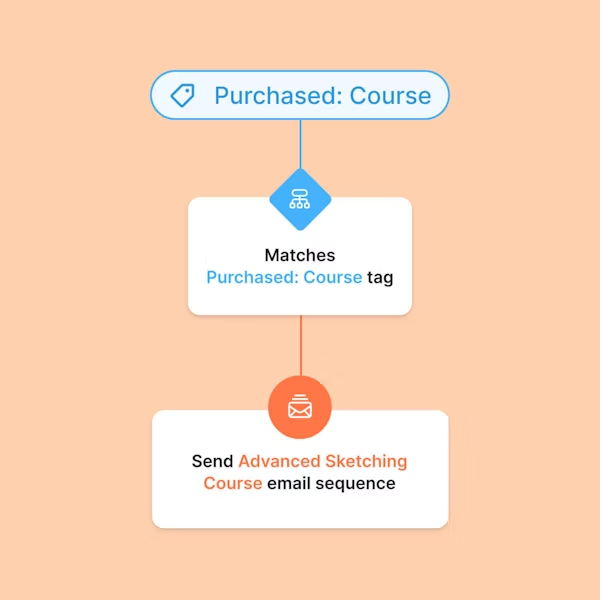
| Free Plan Includes | Why We Love It |
| 10,000 subscribers & Unlimited emails | Massive subscriber allowance—you can grow your list far before you have to pay. |
| Landing Pages & Forms | Collect emails anywhere, even without a website. |
| Sell Digital Products & Subscriptions | Unique feature: Sell e-books, courses, or paid newsletters directly inside the platform. |
| Tagging & Segmentation | Excellent for organizing your audience based on their interests and purchases. |
The Best Overall Option for Serious Creators & Monetization
I use Kit for this site (and on other projects); it’s been my go-to for email marketing since 2018.
It comes with professional-looking landing pages that are perfect for converting social media followers into subscribers.
You have built-in e-commerce for digital products as standard, a plethora of email templates, sequences, and the simplest (and most potent) tagging and segmentation tools on this list.
For most creators, it is all you’re ever going to need.
I’ve looked elsewhere and tried alternative platforms on other projects but when stuff gets serious, I always end up coming back to Kit.
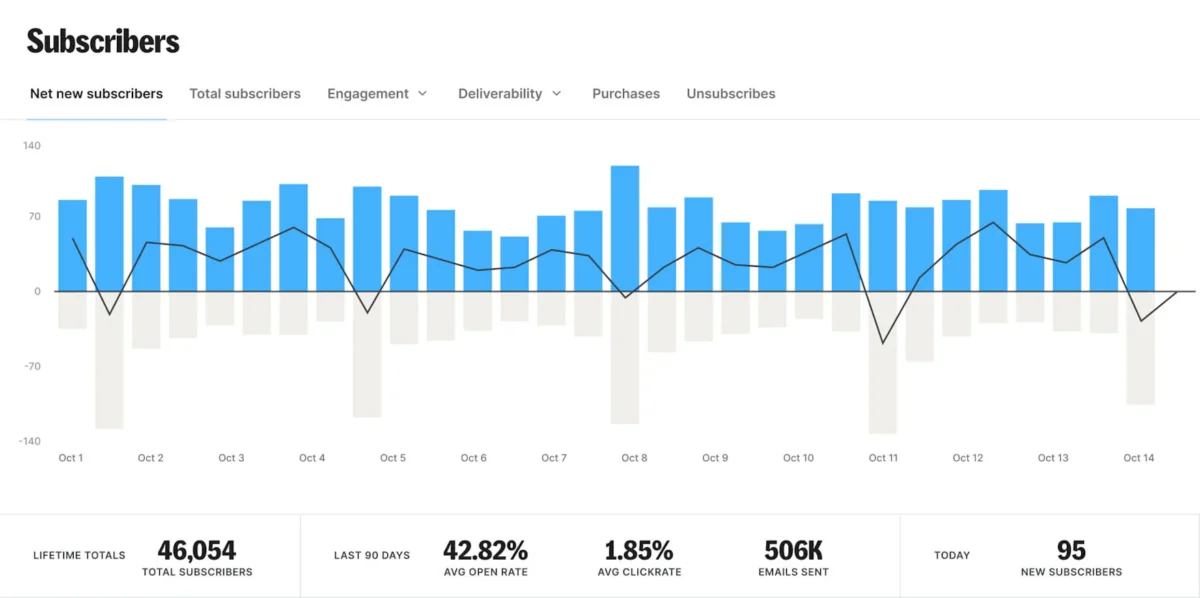
It’s not perfect; I’d like more control over templates, for instance, but that’s about it.
Once you know how to use the platform and its core features, it will become the central pillar of your business.
I love the simplicity and power of its list segmentation, it’s a breeze to create and manage multiple sequences.
There are loads of great-looking landing pages that can be easily customized for all kinds of offers and lead magnets.
You can run custom fields and custom templates, if you want to get fancy, and there’s loads of free and even paid templates to choose from for your emails.
Its list-focused system, which you can organize with tags and rules, is really simple to get started with right away which means no more paying for duplicate contacts.
The upshot of this kind of list management also means your subscribers ONLY see what they signed-up to see.
For me, the ease of organizing your list in Kit is what makes it so damn useful.
The main reason people unsubscribe is if you keep sending them stuff they’re not interested in.
By organizing your list through rules and tags from the get-go ensures that your audience only gets sent stuff they’re actually interested in.
And the free tier is good enough for testing out the platform before committing to a paid plan.
Key Drawback: The free plan limits you to one visual automation and one email sequence, and requires you to display other recommended newsletters (Creator Network).
2. Beehiiv 🐝
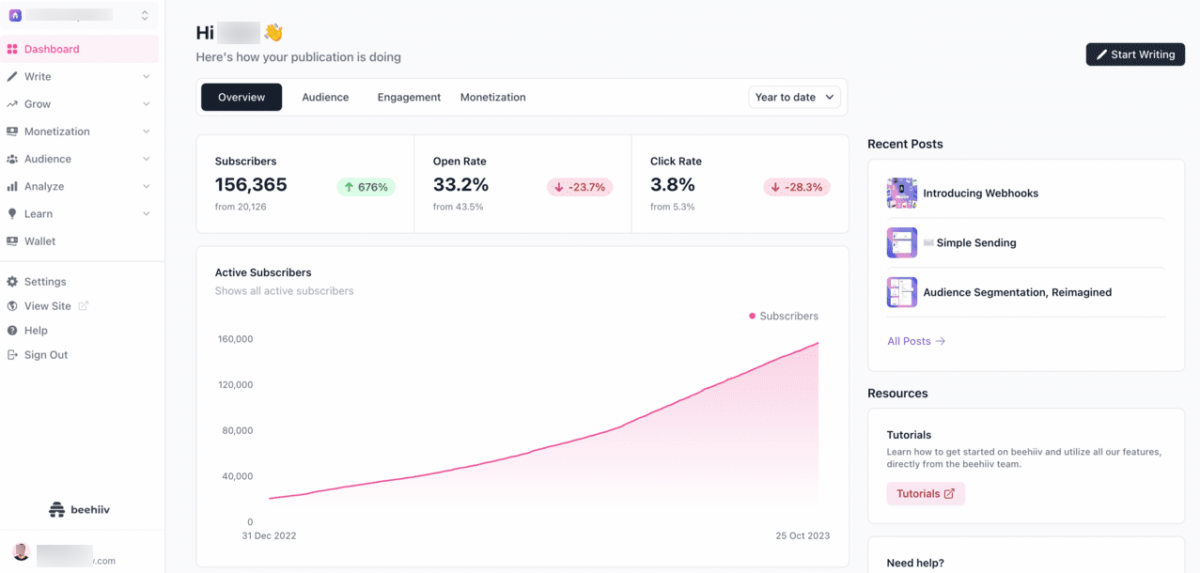
| Free Plan Includes | Why Creators Love It |
| 2,500 subscribers & Unlimited emails | A respectable subscriber allowance with no limit on how often you can email them. |
| Website Builder & Custom Domain | Get a professional website/archive for your newsletter built right in. |
| 3 Newsletters / Publications | Perfect if you manage distinct content niches or side projects. |
| Audience Growth Tools | Includes features like their recommendation network for audience swapping with other creators. |
The Best All-in-One Newsletter Publishing Platform
Developed by the team that helped create Morning Brew, Beehiiv is easily the most talked about and hyped newsletter on this list.
It’s also the newest, having only been launched a few years ago.
Developed as the “ultimate modern newsletter platform”, Beehiiv iterates new features and updates on an almost weekly basis, and the core platform is very strong.
It has growth tools, an ad network for monetizing and growing your list, a website builder where you can house posts, pages, and newsletter updates, and paid newsletter features.
Beehiiv also takes 0% cut of your subscription revenue too which, compared to Substack’s 10%, is a very nice hook for both new users and legacy Substackers looking to switch.
| USP | Creator Benefit |
| Integrated Growth Features | Unlike competitors, Beehiiv embeds powerful growth tools like a native referral program and their Boosts network directly into the platform. This allows creators to turn existing readers into acquisition agents and acquire new, targeted subscribers through paid cross-promotion. |
| Built-in Monetization Ecosystem | It features the Beehiiv Ad Network and premium content paywalls natively. Creators can monetize through ads, sponsorships, or paid subscriptions without integrating third-party tools. This streamlined revenue engine is central to its appeal. |
| All-in-One Publishing | Beehiiv combines a sleek writing editor with a no-code website builder and strong SEO capabilities (custom domains, meta editing). This allows creators to launch a professional, branded newsletter and a web archive without needing a separate website or hosting. |
| 0% Fee on Paid Subscriptions | Critically, Beehiiv takes no cut of a creator’s subscription revenue, unlike competitors like Substack. Creators only pay the standard Stripe processing fees, maximizing their take-home income. |
I’ve used Beehiiv on a couple of projects, one of my own and another one when doing some client work, and while it does have a lot going for it, I’m not a fan of its dashboard and back-end.
There’s a mountain of hype about the platform online, so rather than gushing about what it can do and why iT’s ThE bEsT NeWsLetTeR PLatForM EveR, I’m gonna focus on the things I don’t like about using it.
The big one, for me, at least, is its backend. I just really don’t like using it.
It’s busy, it’s fiddly, and the endless drop-down menus make it feel like wading through treacle to get your basic, boilerplate template setup.
Third-party integrations are limited, and it doesn’t play well with external sites, and the signup forms are terrible (on the free plan).
So bad, in fact, that you’ll have to use a third-party alternative which means more money being spent.
But the biggest issue for me personally, and the reason why I stopped using it, was because I just didn’t like working inside the platform.
Beehiiv also likes to play it fast and loose with updates, pushing out new features when they never should have left beta.
Given the size of some of the companies that use it, this approach is bonkers.
One update last year, pushed out without proper testing, completely changed the look and feel of the templates. The fonts changed, the title styling. Everything.
It was after this that I decided to move my list away from Beehiiv; it wasn’t for me. I don’t enjoy using its backend and the updates are just too all over the place for my liking.
Plus, all the features that make Beehiiv truly unique, its growth and monetization engines, are locked behind its paid tiers.
| Limitation | Impact on the Free User/Creator |
| Strict Subscriber Limit | You can only have up to 2,500 subscribers. A rapidly growing newsletter will hit this cap quickly, forcing an immediate, unplanned upgrade to avoid disrupting list momentum. |
| Monetization is Disabled | The platform’s key revenue tools—the Ad Network, Boosts, and premium content paywalls—are completely unavailable. Free users cannot earn direct revenue through the platform. |
| No Marketing Automation | The free plan excludes email automations (like welcome sequences or drip campaigns) and advanced segmentation or custom fields. This prevents creators from nurturing new subscribers or creating sophisticated, targeted funnels. |
| Limited Branding and Design | You cannot access advanced design customization options (like specific fonts and colors) or connect a custom domain for forms and landing pages, potentially weakening your brand’s professional appearance. |
| Lack of Priority Support | Free users receive standard support, resulting in slower response times for technical or migration issues. This can be disruptive if a new creator encounters setup problems. |
| Reduced Analytics Power | You miss out on premium analytics, which means you cannot track specific subscriber behavior or optimize content with the same precision available to paid users. |
Key Drawback: You cannot access monetization tools (paid subscriptions) or email automations (like welcome sequences) on the free plan, a significant limitation compared to Kit.
3. MailerLite 💡
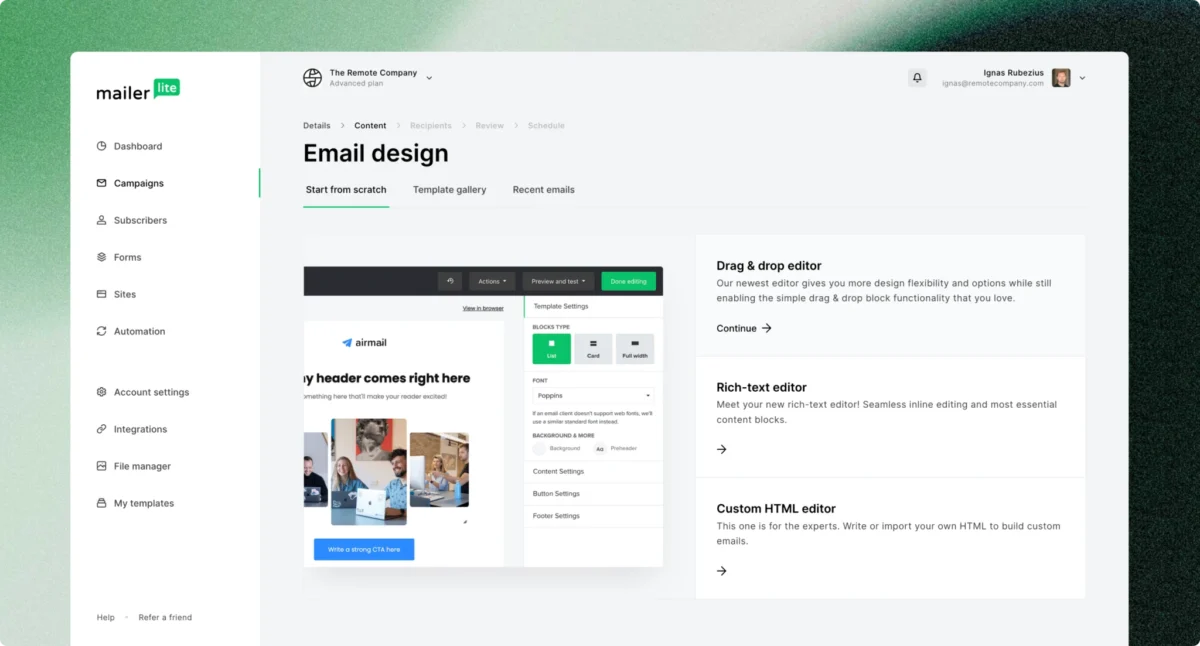
| Free Plan Includes | Why Creators Love It |
| 500 subscribers & 12,000 emails p/m | Good volume for a small, active list. |
| Simple Automations & Landing Pages | Unlike many competitors, MailerLite includes single-trigger automation workflows on its free tier. |
| Reports & Forms | All the basic features you need to track what’s working and collect leads. |
The Best for Intuitive Simplicity & Free Automation
MailerLite is fine. It’s cost effective, simple enough to use, and it does the basics very well indeed.
I used it on a project last year. I needed a quick and simple way to start collecting email for an e-commerce site I was helping to set-up.
It was on WordPress, using WooCommerce. And for this, MailerLite was surprisingly good. It plays nice with WordPress, it comes with forms and pop-ups, and it has list segmentation and sequences.
But for a creator, I’d argue it’s too limited to build your business around. Yes, it’ll do e-commerce stuff but you’ll need to use a dedicated e-commerce platform like Shopify or Woo.
Also, on the free tier the templates are bloody awful.
There’s also the fact that once you get going with email marketing, you inevitably hit a ceiling with MailerLite.
You’ll want to do things it simply cannot do, like advanced automations or funnels.
And then you’ll have to migrate to another platform which is a pain in the ass.
MailerLite is cheap and has enough features for the basics but most creators that get serious will end up with FOMO once their audience starts growing.
And the clincher, for me?
Most creators only sell digital products, so why not just use a newsletter platform that supports digital product sales as well as paid memberships and paid newsletters like Kit?
The key point here is that what you don’t want to be doing is building on one platform and then, once you have some scale, migrate to another platform.
You’re far better off just starting with the right one. This will save you a bunch of headaches in the short, medium, and long term.
4. EmailOctopus 🐙

| Free Plan Includes | Why Creators Love It |
| 2,500 subscribers & 10,000 emails p/m | A very generous allowance for both subscribers and monthly sends. |
| Simple Newsletter Software | Easy to set up and use if you only need to send classic, straightforward newsletters. |
| Affiliate Marketing Friendly | They are more relaxed about senders dealing with niche industries and affiliate marketing, which is a huge plus for content creators. |
The Best for Cost-Conscious Bloggers
I’ve used EmailOctopus on a few quick-turnaround projects—mostly landing pages to collect emails and simple broadcast sequences.
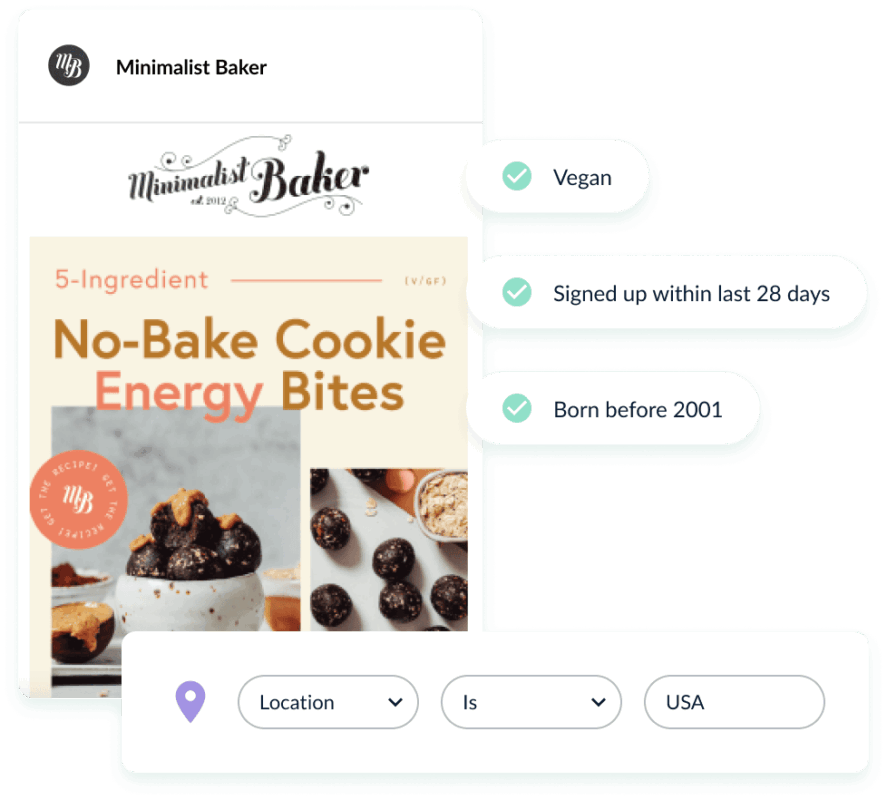
It’s one of those tools that works straight out of the box, no friction, no real learning curve.
And for a lot of creators, that’s exactly what you want when you’re just getting started.
The appeal here is obvious: it’s free (up to 2,500 subscribers and 10,000 emails per month), it’s fast to set up, and it doesn’t try to do too much.
You sign up, build a form or a landing page, plug in your emails, and you’re off.
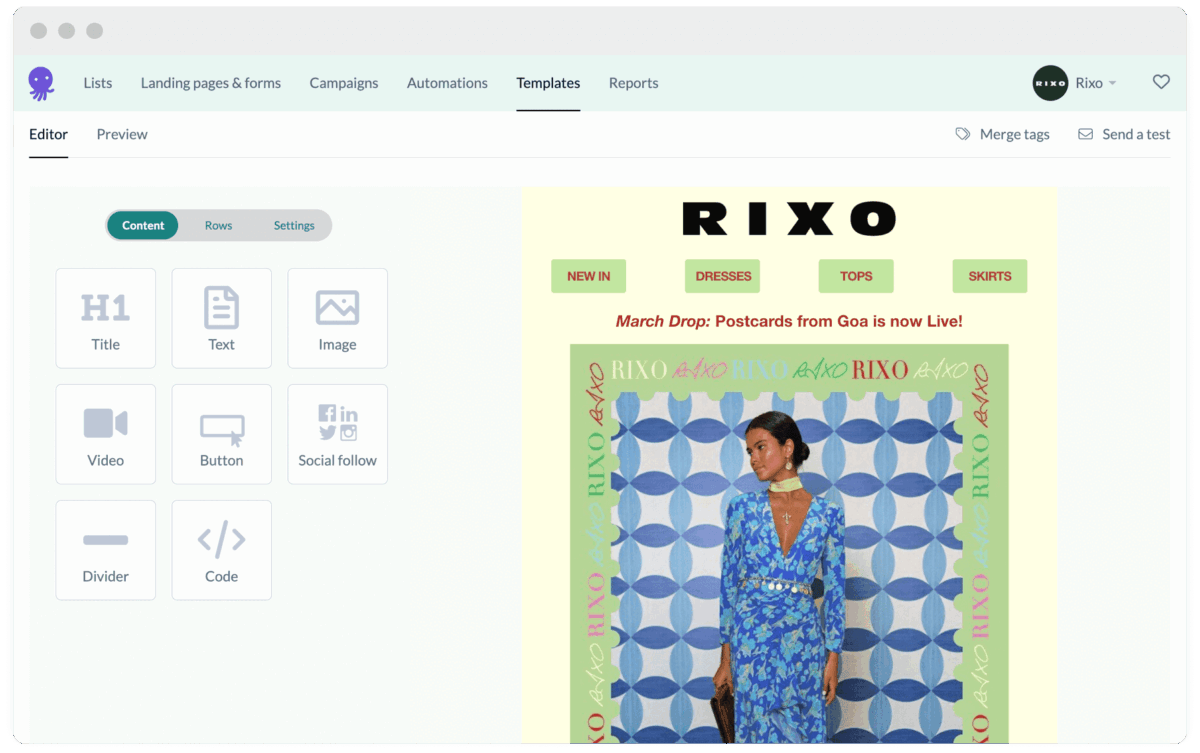
For testing ideas or spinning up side projects, it’s easily one of the better free-tier email platforms out there.
Deliverability is solid—better than I expected, to be honest—and it runs on Amazon SES, which handles that side of things quietly in the background.
Emails landed in inboxes, sequences sent on time, and I never had to think about it.
That’s a win.
Where it starts to show its limitations is once you want more control over design, automation, or growth.
The automation builder is painfully basic. You can set up a welcome sequence or a timed drip, but that’s about it.
No visual editor, no branching logic, no conditional flows.
It’s enough to warm up new subscribers, but that’s where it ends.
The email templates are also very limited, and the ones that are there feel a bit dated.
I usually ended up stripping them down and rebuilding from scratch, which defeats the point of using a template in the first place.

If you want modern layouts or anything branded, you’re better off working in HTML or switching platforms entirely.
There’s also no native A/B testing.
If you want to test subject lines or content blocks, you have to clone your campaign, manually split your list, and track performance yourself.
It works, but it’s clunky and feels like something you shouldn’t still have to do in 2025.
And yeah, while integrations exist, most of them run through Zapier.
Fine in theory, but it adds overhead both in cost and setup time. If you’re trying to keep things lean and native, it’s not ideal.
There are also a few weird UX decisions, like the lack of an undo button in the editor which means you’re rebuilding that block from scratch if you make a mistake.
Not a dealbreaker, but annoying when you’re working fast.
Still, for simple newsletters or landing page lead-gen, it’s hard to knock what EmailOctopus offers for free.
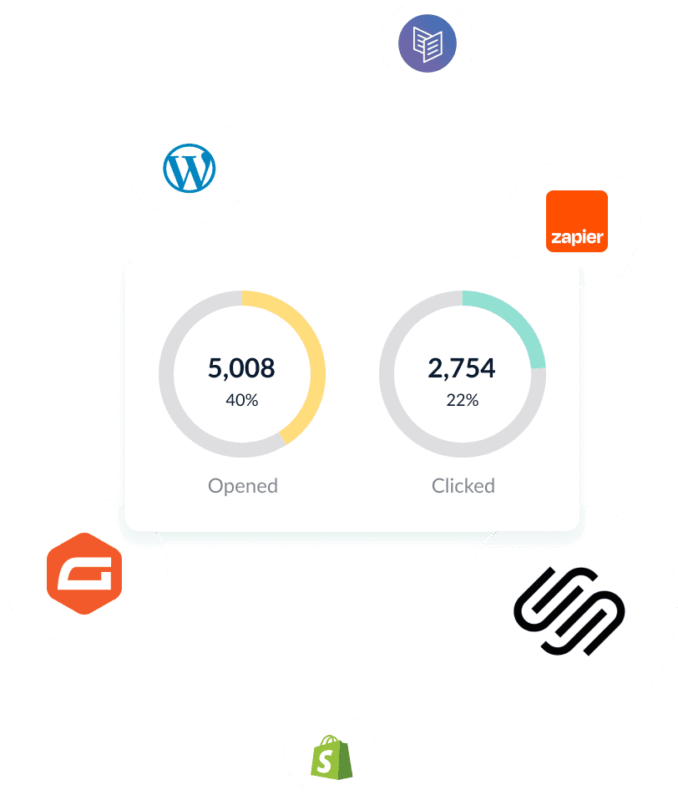
I’ve recommended it to plenty of creators who just need something that works without dragging them into a 30-tab YouTube tutorial rabbit hole.
It’s perfect for small lists, early validation, or MVPs.
But once you want smarter automations, cleaner templates, or deeper analytics, you’ll hit a wall and when you do, you’ll probably move on, and my go-to right now for that would be Kit.
Key Drawback: The feature range is limited; it lacks advanced tools like visual automations. You also only get customer support for the first 30 days on the free plan.
Things To Keep In Mind, Final Thoughts
Which Free Platform Gives Creators the Highest Subscriber Limit?
If your priority is list size, ConvertKit (now branded as Kit) offers one of the most generous free plans.
You can manage up to 10,000 subscribers and send unlimited emails, which is miles ahead of most competitors.
By comparison, tools like MailerLite usually cap you at 1,000 subscribers, while EmailOctopus tops out at 2,500.
For creators focused on growth without immediate costs, ConvertKit’s free tier is tough to beat.
Can I Sell Digital Products or Paid Newsletters on a Free Plan?
Both ConvertKit and Beehiiv let you sell digital products, run paid newsletters, and add subscriptions while still on their free tiers.
The trade-off is transaction fees, which the platforms take as a cut of your sales.
Still, if you’re testing a monetization strategy, it’s a useful way to start without upfront investment.
What’s the Biggest Limitation of “Free Forever” Plans?
The catch is usually in advanced features.
Free tiers strip back automation and analytics to the bare minimum.
Expect one basic welcome sequence at best, limited customization (and a “Powered by” logo you can’t remove), no native A/B testing, and only surface-level reporting.
These plans are designed to get you started, not to scale a serious business.
Which Free Platform Is Easiest for Beginners?
Kit is the standout here.
Its editor is clean, fast, and simple enough that you don’t need to read a guide to get started.
If your main goal is creating good-looking newsletters without overthinking design or settings, Kit is one of the easiest tools to use.
When Should You Upgrade From Free to Paid?
Don’t upgrade just because you can, upgrade when you need a feature.
The tipping points usually fall into two categories:
1) You want more sophisticated automations (like multiple welcome flows or action-based funnels)
2) You’re ready to strip platform branding from your emails, or you’ve outgrown the subscriber cap.
If your business is scaling and you’re serious about conversions, you’ll start to realize you need features that just aren’t available in the free plan.
And this is when it is usually time to upgrade.
